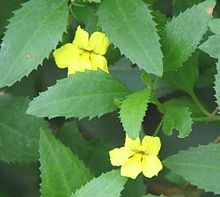Goodenia
Appearance
| Goodenia | |
|---|---|

| |
| Goodenia ovata | |
| Scientific classification | |
| Kingdom: | Plantae |
| Clade: | Tracheophytes |
| Clade: | Angiosperms |
| Clade: | Eudicots |
| Clade: | Asterids |
| Order: | Asterales |
| Family: | Goodeniaceae |
| Genus: | Goodenia Sm. |
| Species | |
Goodenia is a genus consisting of 179 species of flowering plants. The name was published in 1793 by James Edward Smith in honour of the Bishop of Carlisle Samuel Goodenough.[1] Goodenough was also a botanist and member of the Linnean Society.
Distribution
Only G. konigsbergeri does not occur in Australia but is endemic to Java. G. armstrongiana, G. purpurascens and G. pumilio extend to New Guinea. G. pilosa extends to Indonesia, southern China and the Philippines. All other species are endemic to Australia. They are found in all states, including in arid and semi-arid areas.[2]
Species
Species include:
- Goodenia albiflora – white goodenia
- Goodenia hederacea – ivy goodenia, forest goodenia
- Goodenia lanata – trailing goodenia, native primrose
- Goodenia lineata
- Goodenia macmillanii – pinnate goodenia
- Goodenia ovata – hop goodenia
- Goodenia paniculata – branched goodenia
- Goodenia stelligera - spiked goodenia
- Goodenia stobbsiana
References
- ^ R.C. Carolin (1992). "Flora of Australia Online (Goodenia)". Flora of Australia Volume 35. ABRS.
- ^ "Goodenia". FloraBase. Western Australian Government Department of Biodiversity, Conservation and Attractions.
